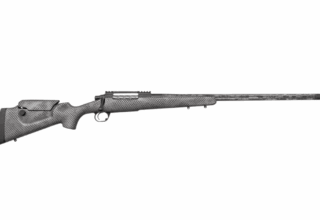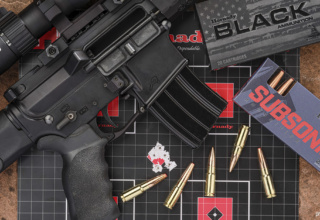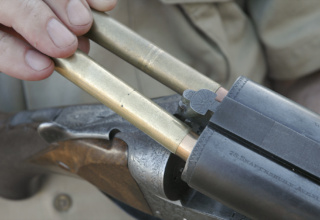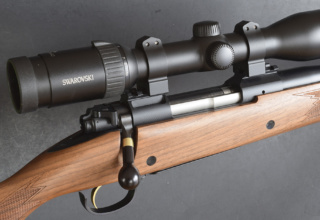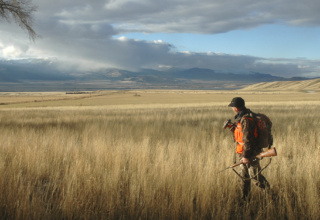They all send bullets fast and flat. They kill reliably and don’t beat you up. Is there a best 6mm?
by Wayne van Zwoll
“Right now,” wrote Field & Stream shooting editor Warren Page in 1953, “I am messing around with the….243 Rock Chucker…I think there’s [promise] in the 6mms and wouldn’t fall over dead if sometime there were a commercial cartridge using that bullet diameter.”
Two years later his prophesy bore fruit in the .243 Winchester and .244 Remington.
But a factory-loaded 6mm had already arrived. The 1895 Lee Straight Pull rifle chambered the .236 or 6mm Lee Navy. Winchester built 15,000 under military contract. Alas, powders of that day didn’t give small-bores their due. The .236 nudged 112-grain round-nose bullets at 2,560 fps. Remington and Winchester hunting rifles couldn’t save the round. It fell from commerce around 1935.

Great Britain gave sixes more attention. Purdey had the .246 Flanged, with 100-grain .253 bullets at 2,950 fps, in 1921. Holland and Holland’s .240 Flanged Nitro Express and .240 Belted Nitro Express sent .245 bullets at 2,900 and 3,000. The .242 Vickers Rimless Nitro Express of 1923 hurled 100-grain .249 bullets at 2,800 fps. The .244 H&H Magnum, a necked-down .300, later pushed 100-grain .244s to 3,500. In Germany, rimmed and rimless versions of the .244 Halger, a necked-down 6.5×57, were claimed to drive 87-grain .243 bullets at 3,770 fps!

Little happened with 6mms in the U.S. until after WWII, when Fred Huntington shaped his Rock Chucker from .257 Roberts brass and other wildcatters formed the 6mm International from the .250-3000. In the 1950s, Warren Page and Remington’s Mike Walker based the sharp-shouldered .243 Page Pooper on the new .308 Winchester. Walker’s 6×47 emerged from the .222 Remington Magnum, Art Mashburn’s .240 Falcon from a shortened .270.

Winchester designed its .243 after Page’s Pooper but with the .308’s 20-degree shoulder. Factory loads featured 80- and 100-grain bullets. Remington’s .244 on the longer Roberts hull appeared with 75- and 90-grain bullets. That bullet-weight disparity proved significant. Barrels for the .243 had 1-in-10 rifling; those for the .244, 1-in-12. The faster spin, quoth the scribes, best stabilized bullets heavy enough to kill deer. Hunters bought the .243’s versatility. While my first .244 shot well with 90-grain bullets and flattened deer-size game handily, Remington trotted out a “new” 6mm Remington in 1963. Actually, it was the .244 with a new headstamp. Barrels got 1-in-9 rifling.

The .243 is still popular, sales buoyed by a growing range of bullets and loads. Remington’s 6mm has languished, largely because of its late start, partly because, like its .257 parent and 7×57 grandparent, it is a mid-length cartridge. Paul Mauser’s 1898 action was designed for 2.24-inch (57mm) cases loaded to 3.06 inches. Stateside, “long” actions were built for the .30-06, OAL 3.34 inches; short actions to suit the .308, OAL 2.75. The .243’s hull measures 2.05, so keeping OAL to 2.75 is easy. In the 6mm’s 2.23-inch hull, bullets must be seated deep for short-action magazines. Long actions are unnecessarily long.
The 6mm Rem. shows higher speeds in some charts. Early rumor had it .243 factory loads were tested in 22-inch barrels, 6mms in 26-inch — and that .243s were commonly held to 47,900 psi while the 6mm could run to 51,000. Truly, handloaded to 50,000 psi with IMR 4350, both toss 100-grain bullets at about 3,100 fps from short actions. The Remington has an edge if you’ve room to seat long bullets out.

In 1968 Roy Weatherby announced a .240 Magnum. Unlike his other hotrods, it was not based on the .300 H&H. Its 2.50-inch, .30-06-size hull has Weatherby’s radiused shoulder junctures but a standard .473 head. A 70-grain bullet clocks a blistering 3,850 fps; 90- and 100-grain missiles 3,500 and 3,395.
Two years ago at this writing, the 6mm Creedmoor was sired by the popular 6.5 Creedmoor, itself offspring of the .30 T/C. Both Creedmoor cases mic 1.92 inch. On both, the shoulder is set well back so bullets with Pinocchio noses can be loaded for short actions without seating ogives below the case mouth. Though a 6mm C no doubt occurred to hunters soon after the 6.5’s 2009 debut, PRC competition gave both rounds a big boost. A survey of PRC enthusiasts showed more than 85 percent using a 6mm. In popularity, the 6mm C quickly gained on the Dasher (from the squat 6mm BR). The Creedmoor boasts 20 percent greater capacity.

Hornady loads the 6mm C with 103-grain ELD-X and 108-grain ELD Match bullets, at 3,050 and 2,960 fps. They fly very much alike, differing by just 7 ft-lbs in energy, 2 inches in drop at 500 yards. The 6mm C stays supersonic past 1,300 yards, but hits you with less recoil than 143-grain bullets from the 6.5 C. With long-range loads, this 6mm requires fast spin. Ruger’s RPR is rifled 1-in-7.7.
I came to know the 6mm C with a custom rifle wearing a Proof Research barrel. The indoor range nixed wind, and the computer screen registered just one hole after two shots. A third hardly enlarged it. No fool, I begged to quit right there. My host would have none of it. Two more shots egged the hole to .2.

Another 6mm, the .243 Winchester Super Short Magnum, appeared in 2004, launching 55-grain bullets at 4,060 fps; 100-grain at 3,110. This squat, rimless round followed the more practical WSMs as U.S. Repeating Arms faded away. The .243 WSSM was orphaned. The mourning is muted.
I am a bit puzzled there are now only four 6mms factory loaded for hunting rifles. While all are well designed and useful — and we hardly need more sixes — .22s, 7mms, and .30s number as the sands of the sea in comparison.

The .243 draws riflemen buying for wives and youngsters. But truly, everyone shoots better with gentle rifles! Loud reports and hammered clavicles cause flinching. A .243 is half as violent as a .280 and lands only a third the blow of a .300 Winchester.
Is the .243 marginal for big game? Hardly! After its first season, a survey recorded 83 kills, most of them deer. Sixty dropped instantly. Thirteen died within 200 yards. Only six had to be trailed. Recent bonded and all-copper bullets fly flat and lose negligible weight driving deep in deer. They hit as hard at 400 yards as a .30-30 at 200. I’ve seen elk fall to Nosler’s 95-grain Partition.

In sales, the .243 handily laps the 6mm Remington. Responses from a 1999 survey I took of 250 Utah deer hunters showed 13 using the .243 but no one with a 6mm Remington!
The limited chambering of Weatherby’s .240 (mainly in Weatherby Vanguard and six-lug Mark V rifles) denies it well-deserved kudos. Norma still makes Weatherby-branded .240 ammo, now with 85-grain Barnes TSXs at 3,500 fps and 100-grain Nosler Partitions at 3,400. Both bring over 1,500 ft-lbs to 300 yards. Vanguard rifles in .240 are fetchingly mild in recoil and have drilled tiny groups for me.

The 6mm C is too new to have earned a field record; it’s the clear leader on the PRC circuit.
Best 6mm? You can hardly make a wrong choice!
Ballistic comparisons, 6mms for predator hunters




